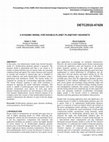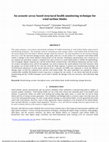Papers by Murat INALPOLAT

International Journal of Intelligent Robotics and Applications
Soldiers working in the field of explosive ordnance disposal (EOD) wear cumbersome personal prote... more Soldiers working in the field of explosive ordnance disposal (EOD) wear cumbersome personal protective equipment (PPE) that may affect their performance in the field, limit their mobility, and cause discomfort. The objective of this study was to develop a test methodology to identify the relationship between EOD suit interface loads and mission-critical performance metrics. The physical interactions between an EOD suit and human subjects were monitored using a distributed pressure sensor network to investigate the interface load distribution during EOD-related physical positions and activities. More specifically, a Med-Eng brand Model EOD 8 suit was utilized to evaluate shoulder discomfort and leg mobility restriction. Thirty-four college aged adults of varying athletic abilities completed a test course and walked on a treadmill for 2 min while wearing the EOD 8. Demographic information was collected before testing via a survey and qualitative observations were collected at the end of testing with a questionnaire. After each test course repetition, participants ranked their perceived exertion using the Borg scale. Overall, the time it took participants to complete the test course increased by 17% and participants experienced a 60% increase in perceived exertion while wearing the EOD 8. The region that experienced the most pain and discomfort was the top of the shoulders (59%) and there was a negative correlation (r = − 0.5, p < 0.05) between participants’ body mass index (BMI) and the max shoulder pressure. The groin protector was found to restrict hip rotation when the subject squatted to pick up an object, producing a pressure 30-times higher than without the EOD 8. These results suggest that a range of motion evaluation method for EOD suits and other protective ensemble can be successfully developed using a combination of user feedback and strategically placed pressure sensors. This study implements the largest pressure region ever recorded on the human body and is the first of its kind to investigate the movement restriction of PPE for various practical tasks.

INTER-NOISE and NOISE-CON Congress and Conference Proceedings
In this paper, a generalized nonlinear time-varying multibody dynamic model of dual clutch transm... more In this paper, a generalized nonlinear time-varying multibody dynamic model of dual clutch transmissions (DCT) is presented. The model consists of clutches, shafts, gears and synchronizers, and can be used to model any DCT architecture. A nonlinear clutch model is used to determine the transmitted power to the transmission at any speed and clutch temperature. The clutch can be a single- or multi-plate clutch and can operate in a wet or dry-clutch configuration. A combined kinematic and powerflow simulation enables calculation of gear, shaft, bearing and clutch quasi-static loads as well as gear mesh frequencies following a duty cycle as the input. For the corresponding Linear-Time-Invariant (LTI) system model, natural frequencies and mode shapes are obtained by solving the eigenvalue problem. The modal summation technique is used to determine the steady state forced vibration response of the system. For the corresponding NTV system, Newmark's time-step marching based integration...

INTER-NOISE and NOISE-CON Congress and Conference Proceedings
In this paper, a generalized dynamic model of a shell structure has been developed and utilized f... more In this paper, a generalized dynamic model of a shell structure has been developed and utilized for diagnostics purposes. The dynamic model is three-dimensional, includes the effects of rotary inertia and shear deformation, and can handle moving loads in radial, tangential and axial directions. The model is utilized to determine in-plane radial displacements of the shell structure under concentrated radial loads for different boundary conditions. The periodic loads are constructed using harmonics obtained through the Fourier series expansion method. The modal expansion technique is implemented for calculation of the steady state forced response of the shell structure. A simplified acoustic radiation model is also implemented in conjunction with the dynamic shell model to predict the noise radiated from a rotating circular cylindrical shell structure under different kinematic, loading and boundary conditions. Moreover, forced vibration response and acoustic radiation predicted will b...

Journal of Physics: Conference Series
This paper presents a general overview of the different aspects of a novel structural health moni... more This paper presents a general overview of the different aspects of a novel structural health monitoring technique developed for wind turbine blades. The proposed technique is based upon detecting the changes in acoustic transmission loss due to structural deformation and damage incurred. This acoustics-based damage detection technique consists of two complementary approaches, namely, the active and passive acoustic damage detection approaches. The proposed approaches can be applied to both onshore and offshore turbines and requires minimum number of acoustic sensors positioned internal and external to the blade structure. Both approaches will be detailed from the structural health monitoring, acoustics, aeroacoustics as well as the practical implementation perspective. The potential benefits of using the proposed approaches and the corresponding technology on wind turbine blades is also discussed.

Mechanical Systems and Signal Processing
Abstract The development of a viable structural health monitoring (SHM) technology for the operat... more Abstract The development of a viable structural health monitoring (SHM) technology for the operational condition monitoring of wind turbine blades is of great interest to the wind industry. In order for any SHM technology to achieve the technical readiness and performance required for an operational implementation, advanced signal processing algorithms need to be developed to adaptively remove noise and retain the underlying signals of interest that describe the damage-related information. The wavelet packet transform decomposes a measured time domain signal into a time-frequency representation enabling the removal of noise that may overlap with the signal of interest in time and/or frequency. However, the traditional technique suffers from several assumptions limiting its applicability in an operational SHM environment, where the noise conditions commonly exhibit erratic behavior. Furthermore, an exhaustive number of options exist when selecting the parameters used in the technique with limited guidelines that can help select the most appropriate options for a given application. Appropriately defining the technique tends to be a daunting task resulting in a general avoidance of the approach in the field of SHM. This work outlines an adaptive wavelet packet denoising algorithm applicable to numerous SHM technologies including acoustics, vibrations, and acoustic emission. The algorithm incorporates a blend of non-traditional approaches for noise estimation, threshold selection, and threshold application to augment the denoising performance of real-time structural health monitoring measurements. Appropriate wavelet packet parameters are selected through a simulation considering the trade-off between signal to noise ratio improvement and amount of signal energy retained. The wavelet parameter simulation can be easily replicated to accommodate any SHM technology where the underlying signal of interest is known, as is the case in most active-based approaches including acoustic and wave-propagation techniques. The finalized adaptive wavelet packet algorithm is applied to a comprehensive dataset demonstrating an active acoustic damage detection approach on a ~46 m wind turbine blade. The quality of the measured data and the damage detection performance obtained from simple spectral filtering is compared with the proposed wavelet packet technique. It is shown that the damage detection performance is enhanced in all but one test case by as much as 60%, and the false detection rate is reduced. The approach and the subsequent results presented in this paper are expected to help enable advancement in the performance of several established SHM technologies and identifies the considered acoustics-based SHM approach as a noteworthy option for wind turbine blade structural health monitoring.

Proceedings of the Institution of Mechanical Engineers, Part L: Journal of Materials: Design and Applications
Foams are used in a variety of impact energy absorption applications because of their ability to ... more Foams are used in a variety of impact energy absorption applications because of their ability to engage in large deformations under steady load transfer during the cell collapse. Quantification of the energy absorption capabilities of foams, including those resulting from repeated loading and unloading, is critical to both modeling and prototype development of systems utilizing these important materials. This paper details a novel process of characterizing a cross-linked high-density polyethylene foam for its applicability within helmet liners designed for low-velocity blunt impact. The foams are characterized using various forms of compression testing and physical measurements. The analyses include examination of the tangent modulus, strain hardness, energy absorption ideality, and energy absorption efficiency. Together, these analyses identify the regions of changing behavior of the nonlinear impact absorption material system. A case study for the materials is presented, which rev...

The Journal of the Acoustical Society of America
Enclosures with different geometries constitute the internal sections of various engineering appl... more Enclosures with different geometries constitute the internal sections of various engineering applications including cabins of passenger cars, fuselages of aircraft wings, and internal compartments of wind turbine blades. Acoustic insertion loss from and to these enclosures affect certain objective and subjective acoustic measures along with the ability to detect damage. This presentation describes a thoroughly executed test plan that identifies the effect of geometric imperfections, such as holes, edge splits, and cracks with different severity levels and locations, on the insertion loss from a subscale acoustic enclosure. A composite rectangular prism enclosure, located inside an anechoic chamber, was internally ensonified using a loudspeaker, and an externally located condenser microphone was used to measure the insertion loss under different conditions. One of the faces of the enclosure possessed various size and location imperfections simulating damage. Insertion loss deviations introduced through the...

Journal of Vibration and Acoustics
Wind turbine blades undergo high operational loads, experience variable environmental conditions,... more Wind turbine blades undergo high operational loads, experience variable environmental conditions, and are susceptible to failure due to defects, fatigue, and weather-induced damage. These large-scale composite structures are fundamentally enclosed acoustic cavities and currently have limited, if any, structural health monitoring (SHM) in place. A novel acoustics-based structural sensing and health monitoring technique is developed, requiring efficient algorithms for operational damage detection of cavity structures. This paper describes the selection of a set of statistical features for acoustics-based damage detection of enclosed cavities, such as wind turbine blades, as well as a systematic approach used in the identification of competent machine learning algorithms. Logistic regression (LR) and support vector machine (SVM) methods are identified and used with optimal feature selection for decision-making via binary classification algorithms. A laboratory-scale wind turbine with h...

Conference Proceedings of the Society for Experimental Mechanics Series, 2016
Double planet planetary gear sets have significantly more design options than their single planet... more Double planet planetary gear sets have significantly more design options than their single planetary counterparts as the addition of the second planet set allows for greater flexibility in sizing and synthesizing transmission kinematic chains. Generally, the primary design constraints for these systems are based on transmitted load, speed ratio, and availability of space. However, once these specifications are met, few attempts are made to optimize the design any further as manual design techniques fail to assess all performance related aspects of the system. In this paper, a methodology to improve existing double planetary gear sets through adjustment of limited set of feasible design constraints is proposed. The improvement will be achieved through modifying the values of gear tooth profile shift, tooth thickness, and planet gear center distances. Design of experiments (DOE) approach is implemented to generate a finite set of models that accurately represent the entire design space. In order to investigate if the proposed alternative designs are an improvement from the baseline system, a finite element tool is used to model all of the potential configurations. The parameters that are used for the fundamental measurement of system performance in this study are bearing forces, gear mesh forces and transmission error spectra.

Conference Proceedings of the Society for Experimental Mechanics Series, 2016
Wind turbine blades are exposed to continuously-varying aerodynamic forces, gravitational loads, ... more Wind turbine blades are exposed to continuously-varying aerodynamic forces, gravitational loads, lightning strikes, and weather conditions that lead the blade damage such as leading and trailing edge splits, cracks and holes. In this study, actively-controlled acoustic sources were utilized in order to excite the blade’s cavity structure from internal. The blade damage manifests itself in changes to the acoustic cavity frequency response functions and to the blade acoustic transmission loss. Proposed research examines the use of wireless sensing approach for detecting surface damage of the blades, while they are rotating when wind turbine is operational. A subscale wind turbine was built and used for carrying out preliminary experimental studies. Sensing system and strategy was benchmarked both using computational (FEM) model of the blades as well as the experimental results in the lab.

Volume 8: 28th Conference on Mechanical Vibration and Noise, 2016
Wind turbine blades undergo high operational loads, experience variable environmental conditions,... more Wind turbine blades undergo high operational loads, experience variable environmental conditions, and are susceptible to failures due to defects, fatigue, and weather induced damage. These large-scale composite structures are essentially enclosed acoustic cavities and currently have limited, if any, structural health monitoring in practice. A novel acoustics-based structural sensing and health monitoring technique is developed, requiring efficient algorithms for operational damage detection of cavity structures. This paper describes a systematic approach used in the identification of a competent machine learning algorithm as well as a set of statistical features for acoustics-based damage detection of enclosed cavities, such as wind turbine blades. Logistic regression (LR) and support vector machine (SVM) methods are identified and used with optimal feature selection for decision making using binary classification. A laboratory-scale wind turbine with hollow composite blades was bui...

In this paper, a computational model is developed to investigate the influence of tooth spacing e... more In this paper, a computational model is developed to investigate the influence of tooth spacing errors on the dynamics of spur gear pairs. This finite element based computational model implicitly includes periodically-time varying gear mesh stiffness and nonlinearities caused by tooth separations in resonance regions. The model can simulate the long period transmission error induced dynamic response from a spur gear with different spacing error patterns and predicts both time domain histories and frequency-domain spectra of dynamic mesh force and dynamic transmission error. The dynamic responses due to both deterministic and random teeth spacing errors are predicted and compared to the previously generated results from a lumped parameter model capable of utilizing experimentally measured transmission error as the realistic excitation mechanism. This study also enables creation of an extensive database of dynamic response spectra of gear pairs under the influence of spacing errors that will later be utilized for investigating the diagnostics of gear pairs. Case 1: Baseline gears with no spacing errors (compared to results from [15]). Case 2: Pinion has a spacing error pattern of 0 15 0 µm, gear has no error. Case 3: Pinion and gear both have a spacing error pattern of 0 15 0 µm. Case 4: Pinion has a spacing error pattern of 0 15 0 µm and gear has a spacing error pattern of 0 -15 0 µm. Case 5: Pinion has a spacing error pattern of 0 -15 0 µm and gear has a spacing error pattern of 0 15 0 µm. Case 6: Pinion and gear both have a spacing error pattern of 0 -15 0 µm. Case 7: Pinion has a sinusoidal indexing error pattern with a peak value of 15 µm, gear has no error. Case 8: Pinion and gear both have sinusoidal indexing error patterns with a peak value of 15 µm. Case 9: Pinion and gear both have random spacing error patterns with a tolerance range of [-15 15] µm.

In this study, a two-dimensional, steady-state, discrete dynamic model of a double-planet planeta... more In this study, a two-dimensional, steady-state, discrete dynamic model of a double-planet planetary gearset is proposed. The dynamic model is generalized such that it can consist of number of planet branches and can operate under any operating conditions (load and speed). The contact between each external to external and external to internal gear pair is modeled to obtain stiffnesses and mesh displacement excitations using a generalized load distribution model. The natural modes are computed by solving the corresponding eigenvalue problem. The forced vibration response to gear mesh excitations is obtained by applying the modal summation technique. The model is capable of predicting gear mesh dynamic load and dynamic transmission error spectra for each gear mesh, dynamic bearing load spectra for each bearing as well as gear body dynamic displacements. Forced vibration response of an example system that consists of three double-planet branches is studied to demonstrate the influence of some of the key design parameters.
A transverse-torsional dynamic model of a spur gear pair is employed to investigate the influence... more A transverse-torsional dynamic model of a spur gear pair is employed to investigate the influence of gear tooth indexing errors on the dynamic response. With measured long-period quasi-static transmission error time traces as the primary excitation, the model predicts frequency-domain dynamic mesh force and dynamic transmission error spectra. The dynamic responses due to both deterministic and random tooth indexing errors are predicted.

Radiation and power flow characteristics of plate-like structures which constitute the bodies of ... more Radiation and power flow characteristics of plate-like structures which constitute the bodies of the well-known engineering applications like cars and household appliances is a primary research field in vibroacoustics. In this study, representative radiation characteristics of plates is examined on the surface of a 300 mm x 300 mm steel square plate excited by a shaker at its midpoint. Two-microphone sound intensity measurement with a probe utilizing side-by-side configuration is used to analyze the near-field radiation characteristics. Surface intensity is simultaneously measured on the plate with another probe consisting of a condenser microphone and an eddycurrent non-contact displacement transducer to compare the results with the twomicrophone sound intensity measurement. Structural intensity technique is utilized for visualization of the power flow throughout the plate's surface. Sound power levels and radiation efficiencies are determined by these two acoustical methods and results are compared with those obtained from an analytical model of the radiating plate. In this particular model, the plate is modeled by a collection of small baffled pistons with equal areas functioning in their own true phases. It is also shown that both experimental methods yield reasonably close results, at especially low frequencies, and analytical results obtained from the model display a similar trend with the experimental results.
Near field radiation behavior of a free-free, lightly damped square plate, which is excited at it... more Near field radiation behavior of a free-free, lightly damped square plate, which is excited at its midpoint, is analytically and experimentally studied. First, the plate is computationally discretized into equal segments that are replaced by simple, phase-correlated acoustic sources. Piston radiator models (with and without mutual radiation impedance terms) are examined along with the pulsating sphere model. The radiated power from phase-correlated discrete sources is calculated; their individual phases are obtained from the surface vibration measurements.
Mechanical Systems and Signal Processing, 2015
ABSTRACT

Structural Health Monitoring and Inspection of Advanced Materials, Aerospace, and Civil Infrastructure 2015, 2015
This paper proposes a non-contact measurement technique for health monitoring of wind turbine bla... more This paper proposes a non-contact measurement technique for health monitoring of wind turbine blades using acoustic beamforming techniques. The technique works by mounting an audio speaker inside a wind turbine blade and observing the sound radiated from the blade to identify damage within the structure. The main hypothesis for the structural damage detection is that the structural damage (cracks, edge splits, holes etc.) on the surface of a composite wind turbine blade results in changes in the sound radiation characteristics of the structure. Preliminary measurements were carried out on two separate test specimens, namely a composite box and a section of a wind turbine blade to validate the methodology. The rectangular shaped composite box and the turbine blade contained holes with different dimensions and line cracks. An acoustic microphone array with 62 microphones was used to measure the sound radiation from both structures when the speaker was located inside the box and also inside the blade segment. A phased array beamforming technique and CLEAN-based subtraction of point spread function from a reference (CLSPR) were employed to locate the different damage types on both the composite box and the wind turbine blade. The same experiment was repeated by using a commercially available 48-channel acoustic ring array to compare the test results. It was shown that both the acoustic beamforming and the CLSPR techniques can be used to identify the damage in the test structures with sufficiently high fidelity.











Uploads
Papers by Murat INALPOLAT